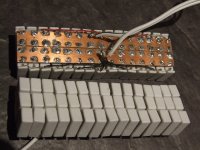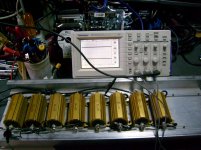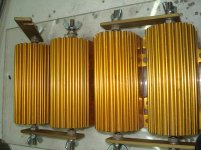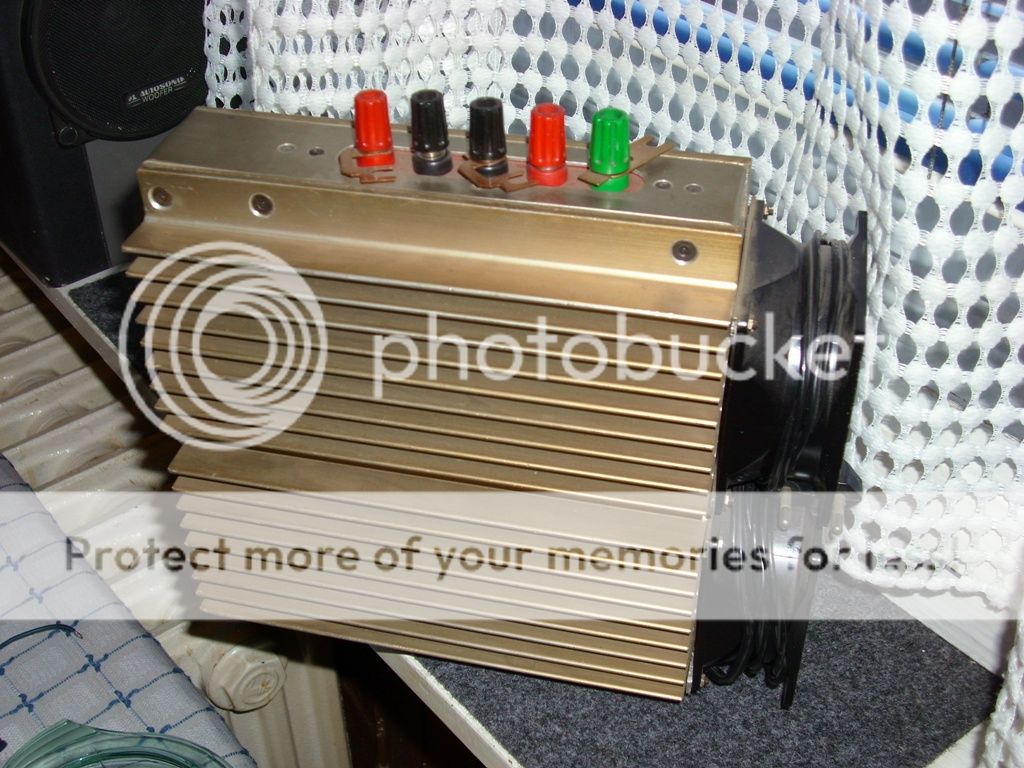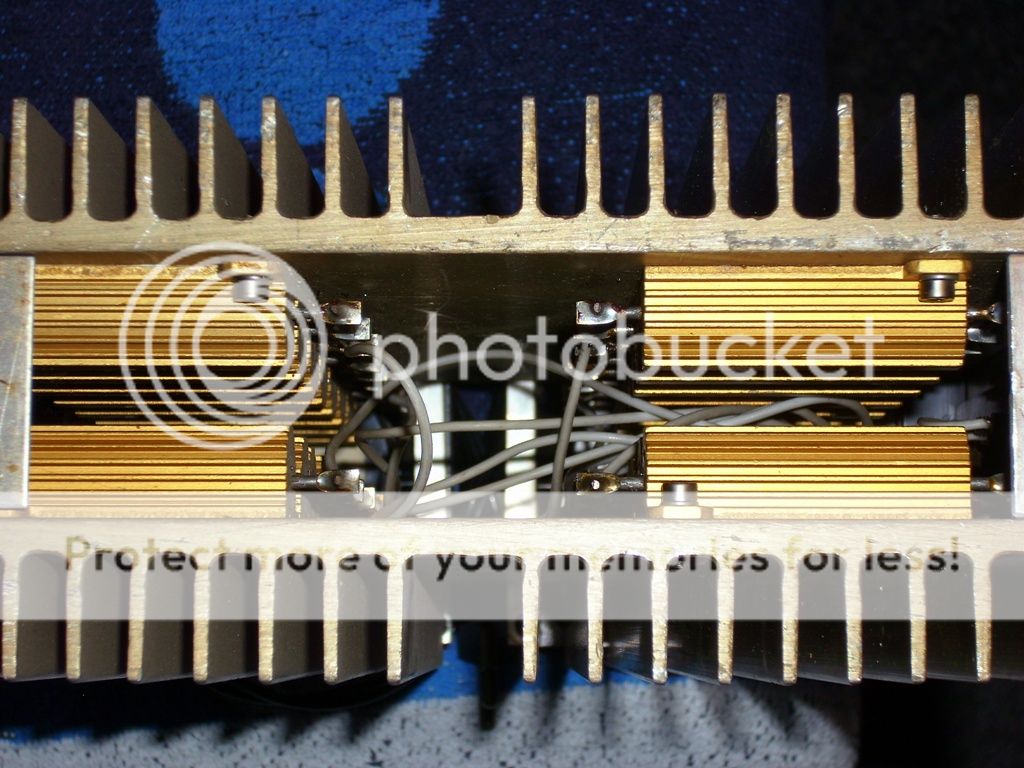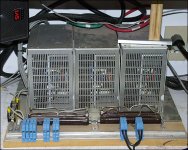Any opinions on how well these would work? I am thinking about buying 8 of them, it would only be 400 watts worth but at short tests I am sure they could handle much more?
8 Ohm 50W Watt Ceramic Tube Wirewound Resistor Fix | eBay
Maybe these would be better?
http://www.ebay.com/itm/Ceramic-Tub...572?pt=LH_DefaultDomain_0&hash=item51a48f8ac4
8 Ohm 50W Watt Ceramic Tube Wirewound Resistor Fix | eBay
Maybe these would be better?
http://www.ebay.com/itm/Ceramic-Tub...572?pt=LH_DefaultDomain_0&hash=item51a48f8ac4
Might be cheaper and certainly easier to use by stringing together 5W wirewounds.
Buy a hundred or two at the best discount you can find.
4 off 10r strung together in series for 40r and then 8 strings in parallel for 4r0 @ 160W.
build 4 or six of these for dummy loads.
2 in series for 8r0 320W.
2 in parallel for 2r0 320W
4 in series/parallel for 4r0 640W
6 in series/parallel for 3r33 or 6r0 960W
I used 3 off 20r series for 60r, then 15 parallel strings for 4r0 @ 220W.
180 resistors gave me 4 dummy loads.
Buy a hundred or two at the best discount you can find.
4 off 10r strung together in series for 40r and then 8 strings in parallel for 4r0 @ 160W.
build 4 or six of these for dummy loads.
2 in series for 8r0 320W.
2 in parallel for 2r0 320W
4 in series/parallel for 4r0 640W
6 in series/parallel for 3r33 or 6r0 960W
I used 3 off 20r series for 60r, then 15 parallel strings for 4r0 @ 220W.
180 resistors gave me 4 dummy loads.
Attachments
Last edited:
THIS type of resistor is very durable and requires no heatsink to meet it's power spec.
Use the mounting clips or hang them on wires (strung through their core). Either will allow you to use a fan to force air over the resistor and through its core (for additional cooling). I use two in series to produce a 4 ohm load and add additional 4 ohm pairs with switches to produce the desired load. I've run very large amps on them that could produce 3-4 times their power rating and have never had one fail. I generally test with music. If you used a continuous sine wave for long term testing, you may need to be a bit more conservative.
Use the mounting clips or hang them on wires (strung through their core). Either will allow you to use a fan to force air over the resistor and through its core (for additional cooling). I use two in series to produce a 4 ohm load and add additional 4 ohm pairs with switches to produce the desired load. I've run very large amps on them that could produce 3-4 times their power rating and have never had one fail. I generally test with music. If you used a continuous sine wave for long term testing, you may need to be a bit more conservative.
Audio Power Amp Amplifier Dummy Test Load 4 Ohm 300W | eBay
These ones say they have been ran 16 times their rated power for 5 minutes with no visible flames.
Thats 4800 watts. Read the specs at the lower part of the page and let me know what you think.
These ones say they have been ran 16 times their rated power for 5 minutes with no visible flames.
Thats 4800 watts. Read the specs at the lower part of the page and let me know what you think.
If I was to buy 4 of these and used 4 fans could they handle a good duty cycle?
The image didn't load.
I don't know what you're testing but unless you have a huge power supply or bank of batteries, you're unlikely to damage the 300w resistors. You only need one fan. Mount them so that their ends are directly in front of a 120mm fan and the air blows through them. A 100CFM fan should be enough. If you want to get a bit crazy, you could buy the 9cr1212p0g03 fan. Of course, you'd have to ear ear plugs when it's on. I purchased one to see what it was like and it's insane (for lack of a better word).
I don't know what you're testing but unless you have a huge power supply or bank of batteries, you're unlikely to damage the 300w resistors. You only need one fan. Mount them so that their ends are directly in front of a 120mm fan and the air blows through them. A 100CFM fan should be enough. If you want to get a bit crazy, you could buy the 9cr1212p0g03 fan. Of course, you'd have to ear ear plugs when it's on. I purchased one to see what it was like and it's insane (for lack of a better word).
Just a Pyramid 52 amp power supply, looking for a 100 amp no luck yet.
I have 2 8D batteries I was thinking of running in parallel. That would be about 3600 cranking amps.
Why would I damage the resitors?
Or one of these would do inline with my power supply?
http://www.ebay.com/itm/Northstar-S...Parts_Accessories&hash=item4abcff6891&vxp=mtr
I have 2 8D batteries I was thinking of running in parallel. That would be about 3600 cranking amps.
Why would I damage the resitors?
Or one of these would do inline with my power supply?
http://www.ebay.com/itm/Northstar-S...Parts_Accessories&hash=item4abcff6891&vxp=mtr
Last edited:
Damage from driving too much power into them. With only a 52 amp supply, you won't be able to drive more than about 600w into them. They could easily take that without fans.
You should realize that the dummy loads will become VERY hot when driven for long periods of time. They can even melt the solder off of the terminals. I'd suggest using high-temp wire. No matter what type of wire you use, you should prevent the insulation from touching the resistors. When you wrap the wire onto the lugs, wrap it twice to prevent it from pulling out if the solder melts.
Batteries are OK for short term testing but they become a pain after a while. Add to that the fact that they're only good for a limited period of time and have to be replaced. They also don't start to supply significant current until the voltage has dropped to about 12v. A good power supply is much better. If you can't find a large supply, try to find three 5v power supplies pulled from servers.
You should realize that the dummy loads will become VERY hot when driven for long periods of time. They can even melt the solder off of the terminals. I'd suggest using high-temp wire. No matter what type of wire you use, you should prevent the insulation from touching the resistors. When you wrap the wire onto the lugs, wrap it twice to prevent it from pulling out if the solder melts.
Batteries are OK for short term testing but they become a pain after a while. Add to that the fact that they're only good for a limited period of time and have to be replaced. They also don't start to supply significant current until the voltage has dropped to about 12v. A good power supply is much better. If you can't find a large supply, try to find three 5v power supplies pulled from servers.
Last edited:
OK makes sense. If I run the 2 8D batteries inline with my power supply, what do you think that would gain me as far as wattage I would be able to drive.
The ones I have are about 1500 CA each so 3000 CA
With 4 300 watt resistors in parallel for a 1 ohm load shouldnt they handle the 1200 watts?
Would my supply keep up with the batteries or would I have to use a battery charger.
The ones I have are about 1500 CA each so 3000 CA
With 4 300 watt resistors in parallel for a 1 ohm load shouldnt they handle the 1200 watts?
Would my supply keep up with the batteries or would I have to use a battery charger.
In parallel, they would easily be able to take 1200w. If you test with music and use fans to keep them cool, I'd expect that they would easily take 2000w.
The power supply would be stressed with any load that's greater than its rated output unless you set the voltage on it below 12v. Above 12v, it will supply 100% of the current until the voltage drops to below about 12.5v. At that point it's trying to supply the amp AND charge the batteries.
A battery charger would help but when set to the higher current modes, they typically produce a lot of hum (not really important when using dummy loads) and can cause the voltage to spike to near 20v.
I mentioned the 5v supplies. The attached photo shows one example. They are connected in series and set for equal output totaling 13.5v.
The power supply would be stressed with any load that's greater than its rated output unless you set the voltage on it below 12v. Above 12v, it will supply 100% of the current until the voltage drops to below about 12.5v. At that point it's trying to supply the amp AND charge the batteries.
A battery charger would help but when set to the higher current modes, they typically produce a lot of hum (not really important when using dummy loads) and can cause the voltage to spike to near 20v.
I mentioned the 5v supplies. The attached photo shows one example. They are connected in series and set for equal output totaling 13.5v.
Attachments
Any ideas where to find these supplies? I have no idea what they are called or how to look them up?
A test load should remain at known resistance.
If your dummy load needs to be at that known test load resistance, then it must be cool.
The wire must be cool.
That is very different from using a big sink to get rid of the heat from an overheated wire.
If your dummy load needs to be at that known test load resistance, then it must be cool.
The wire must be cool.
That is very different from using a big sink to get rid of the heat from an overheated wire.
I can't find any right now. These were pulled from mainframe computers. They still show up regularly on eBay.
One of the cheapest options may be to get a rack and 4 of the Pyramid supplies that you have now. You'd likely have to use two mains circuits to use all 4 to their limit.
One of the cheapest options may be to get a rack and 4 of the Pyramid supplies that you have now. You'd likely have to use two mains circuits to use all 4 to their limit.
I mentioned the 5v supplies. The attached photo shows one example. They are connected in series and set for equal output totaling 13.5v.
I have the same:

An externally hosted image should be here but it was not working when we last tested it.

With pot in both PSU change to 2x6 = 12V DC.

Regards zeoN_Rider
The mainframe supplies are generally rated for 100+ amps of current but it's the same principle.
If 12v is enough, you can use a standard computer power supply. The larger supplies like the CMPSU-1200AX can supply a bit over 100 amps from the 12v rails. Some can supply over 150 amps at 12v.
If 12v is enough, you can use a standard computer power supply. The larger supplies like the CMPSU-1200AX can supply a bit over 100 amps from the 12v rails. Some can supply over 150 amps at 12v.
- Status
- Not open for further replies.
- Home
- General Interest
- Car Audio
- Dummy Loads
